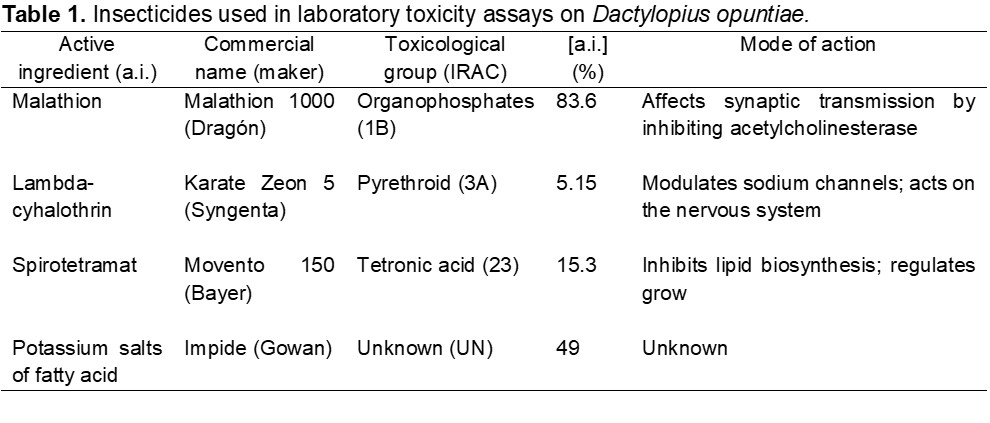Toxicity of four commercial insecticides on Dactylopius opuntiae (Hemiptera: Dactylopiidae)
DOI:
https://doi.org/10.56890/jpacd.v25i.481Keywords:
Prickly pear, nopal, Opuntia ficus-indica, cochineal, chemical control.Abstract
Dactylopius opuntiae (Cockerell) (Hemiptera: Dactylopiidae) is a pest of Opuntia ficus-indica (L.) Miller (Caryophyllales: Cactaceae) in many regions around the world, and there are no formal insecticide toxicity assays. This study aimed to evaluate the lethal toxicity of malathion, lambda-cyhalothrin, spirotetramat, and potassium salts on D. opuntiae in laboratory and greenhouse assays. In the laboratory, using a potter tower, lethal concentrations (LC50 and LC90) were determined on adult females. Under greenhouse conditions, on O. ficus-indica infested plants, the LC90 of those three conventional insecticides were evaluated, as well as the LC50 of potassium salts; mortality was evaluated 48 and 144 h after application in laboratory and greenhouse assays, respectively. D. opuntiae was susceptible to all insecticides; malathion was the most toxic product, LC50 120.4 mg L-1, lambda-cyhalothrin (159.8 mg L-1) and spirotetramat (756.3 mg L-1) followed. Using potassium salts, 8,970.1 mg L-1 were needed to achieve 50% mortality. The highest percentage of mortality (88.3%) in the greenhouse was obtained using the LC50 (8,970.1 mg L-1) of potassium salts and the LC90 of spirotetramat (11,567 mg L-1). Mortality caused by the LC90 of spirotetramat (77.3%) and malathion (66.8%) did not differ statistically; while the LC90 of lambda-cyhalothrin (11,427 mg L-1) caused 45.4% mortality, and it was the least toxic insecticide in the greenhouse assay. In this work, the toxicity of insecticides to improve their use against D. opuntiae is discussed.
Publication Facts
Reviewer profiles N/A
Author statements
Indexed in
- Academic society
- Journal of the Professional Association for Cactus Development
- Publisher
- Professional Association for Cactus Development




